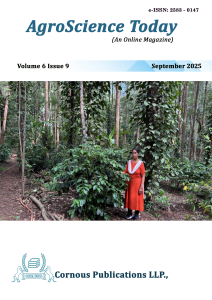Efficient nutrient absorption is a key determinant of plant growth and productivity. In conventional soil-based systems, plant roots absorb essential macro- and micronutrients from the soil solution, a dynamic medium influenced by pH, microbial activity, and nutrient availability. Soilless cultivation systems, including hydroponics, aeroponics, and nutrient film techniques, provide an alternative approach that allows precise control over nutrient delivery, water availability, and environmental conditions. These systems offer several advantages, including higher nutrient uptake efficiency, consistent plant growth, elimination of soil-borne pathogens, and reduced fertilizer losses, making them environmentally sustainable and resource-efficient. However, the absence of soil buffering necessitates careful monitoring of solution pH, electrical conductivity, and oxygenation to prevent nutrient imbalances and optimize root function. Root morphology, particularly the presence of fine roots and root hairs, plays a critical role in nutrient acquisition. Controlled soilless environments often stimulate denser and more branched root systems, enhancing nutrient and water absorption. Empirical studies indicate a strong correlation between root biomass and the uptake of key nutrients such as potassium, calcium, and nitrate in crops like lettuce and tomato. This review highlights the physiological mechanisms of nutrient absorption, the interaction of roots with the growth medium, and the advantages and challenges of soilless cultivation, providing insights for optimizing plant productivity in controlled agricultural systems.
Agriculture and allied sectors are central to India’s economy, providing livelihood to a majority of the population. While the Green Revolution significantly increased crop productivity, it also exposed agriculture to new challenges, including emerging biotic stresses (pests and diseases) and abiotic stresses (drought, extreme temperatures, salinity). Protected cultivation techniques, which involve growing crops in controlled environments, help overcome these challenges by providing optimal conditions for plant growth. Rising food demand, the need for year-round production, and increasing urbanization further emphasize the importance of protected cultivation. Among various methods, greenhouse cultivation has emerged as a key approach, offering high efficiency and productivity. Polyhouse-based farming, in particular, has become a strategic tool in modern Indian agriculture.
The Front-Line Demonstration (FLD) on organic farming of black pepper, implemented under the Mission for Integrated Development of Horticulture (MIDH) at the Horticultural Research Station (HRS), Yercaud, has been effectively operational for over a decade. This initiative has played a pivotal role in promoting awareness and adoption of organic spice cultivation among farmers. By showcasing practical, eco-friendly farming techniques under real field conditions, the FLD serves as a vital platform for knowledge dissemination and capacity building. The demonstration continues to attract and benefit a wide range of visiting farmers, reinforcing sustainable horticultural practices in the region. For over 22 years, a woman farmers Mrs. Premalatha and her family has nurtured a 3.4-hectare plantation in the serene hills of Semmanatham, Yercaud, Tamil Nadu. While organic practices were followed intuitively in the early years, a deeper commitment to organic farming began around five years ago. Through training at HRS, Yercaud, exposure to demonstration units, and learning from experienced farmers, she gradually transformed her approach. This journey has led to healthier crops, enriched soil, and a thriving ecosystem. A recent harvest of 2.70 tons of green pepper from 342 vines marks a significant milestone. More than a livelihood, the land has become a place of learning and inspiration, reflecting the rewards of mindful, patient cultivation.
